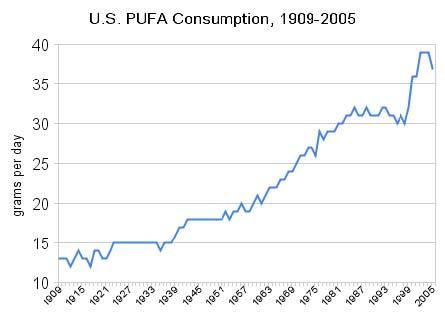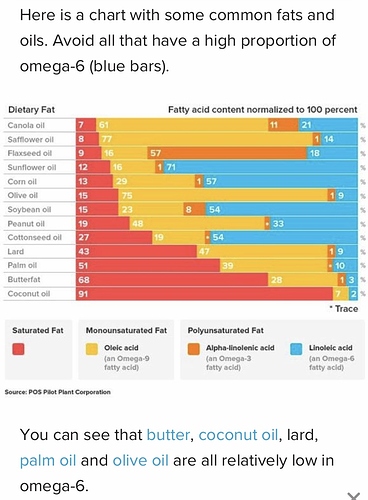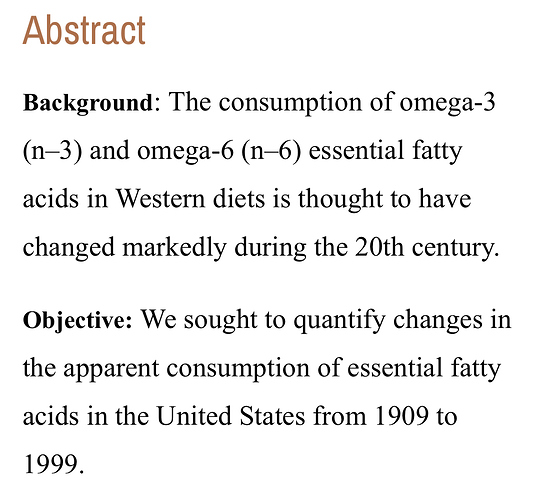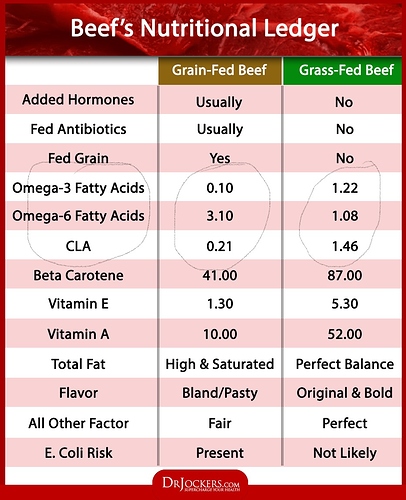From what I understand but I could be wrong is that the 1:1 omega 3 to omega 6 ratio is what is supposed to be in grass fed meat vs. grain fed?
”…Humans should naturally have an omega 6:3 ratio around 4:1 or 2:1 …” - Dr. Jockers[5]
Even intake of saturated fats (butyric acid; helps the body burn body fat) equal to polyunsaturated (PUFA; holds onto body fat but the brain needs it and what the human brain tissue mostly is; omega 3’s). In equal ratios is anti-inflammatory!

A contributing factor of obesity? The other deciding factor how much (amounts) processed sugars are in the diet?
Footnotes:
[1] How much CLA is in grass fed beef? Depending on the breed of cow, grass-fed beef contains between 2 and 5 times more omega-3s than grain-fed beef, and the average ratio of n-6:n-3 in grass fed beef is 1.53:1 …More
[2] Fatty Acid Composition: I mentioned in my previous post that the ratio of saturated to monounsaturated to polyunsaturated fat in beef stays about the same regardless of what the animal is fed. (1) Those ratios might shift slightly depending on the animal’s diet, but the shifts are still relatively small. On average, grass-fed beef tends to have slightly lower levels of MUFA and slightly higher levels of PUFA than grain-fed, but these differences are at most five percentage points, depending on the breed of cattle and the study in question. So regardless of whether your beef is grain-fed or grass-fed, you’ll be getting about 40-50% saturated fat, about 40-50% monounsaturated fat, and somewhere near 10% polyunsaturated fat. However, the diet of the cow does significantly influence the types of each fat present. Within the broad categories of SFA, MUFA, and PUFA, there are several individual fatty acids with different chemical compositions, and each has unique effects on the body. …More
[3] What is better grass fed or grain fed beef?
Grass-fed beef is naturally leaner than grain-fed beef. Omega 3s in beef that feed on grass is 7% of the total fat content, compared to 1% in grain-only fed beef. Grass-fed beef has the recommended ratio of omega 6 to omega 3 fats (3:1.) …More
[4] Changes in consumption of omega-3 and omega-6 fatty acids in the United States during the 20th century:
[5] Grass-Fed Beef: Is It Superior to Poultry The Importance of Omega 6:3 Ratios: Humans should naturally have an omega 6:3 ratio around 4:1 or 2:1. When these ratios become skewed, they trigger cellular inflammation and accelerated cellular degeneration. This environment causes an individual to become highly inflamed and to build degenerative disease (5). …More






